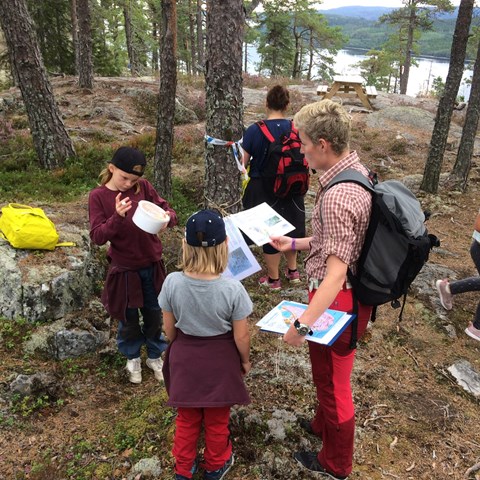Contact
Swedish Centre for Nature Interpretation (SCNI)
Department of Urban and Rural Development, Swedish University of Agricultural Sciences (SLU)
scni@slu.se
www.scni.se

There were held two tests of heritage interpretation onsite in the World Heritage with the heritage interpretation plan as support. Tests were done at Hornöberget at the High Coast during summer 2019 and at Svedjehamn in the Kvarken Archipelago during summer 2020.
At both sites different experience/nature trails were planned. Before the tests temporary versions (prototypes) were being produced, for example road signs, boards, models, u-turns (self powered wind up audio players) and treasure boxes. The prototypes made it possible to test the planned the heritage interpretation before the real ones were produced and put in place. People that represented the proposed target groups were invited to test, reflect over and judge the heritage interpretation. The test persons were assigned a time when they should come and test the heritage interpretation.
The tests were performed by the Regional Administrative Board of Västernorrland and Metsähallitus in cooperation with CNV.
At the High Coast the test was held during two days in August 2019. The test persons that we wanted to participate should represent the following groups in the heritage interpretation plan: Families with children, Not so mobile, Ignorant curious and Scanners. In total 9 families participated. They went around an planned trail, and pretented that it was established, and tested prototypes of planned heritage interpretation. The heritage interpretation at this test focused on the subtheme “One World Heritage but so different” and “The idea of World Heritages”. At the the families got with them a backpack with content, with for example instructions for how they should perform the assignments. See the invitation from the test at the High Coast.
The test in the Kvarken Archipelago was held during two days in August 2020, where one day was assigned especially for families with children and the other day was assigned for those with disabilities. In total around 30 persons took part. The test was based on prototypes for heritage interpretation to a nature trail around the lake Bodvattnet. In the invitation it said that “Bodvattnet will get new information boards and now we want your feedback on them. Come and test the renewed nature trail and experience new ways to tell about the World Heritage High Coast / Kvarken Archipelago.”. See invitations for the test in Kvarken Archipelago here.
The layout was similar for the tests at the High Coast and in the Kvarken Archipelago. While participants took part of the heritage interpretation they were invited to reflect over what they thought was good, what they thought could be improved and if the content aroused any thoughts in them. The latter is important in order to highlight what in the content arouse interest and questions, give new insights or are experienced as fascinating. They were asked to write down their thoughts in a form. Here is the form from the High Coast and here is the form from the Kvarken Archipelago. At the test at the High Coast they would also come up with opinions about a model of land uplift - see the form for the model here.
When the participants had taken part of all the heritage interpretation they were interviewed with questions based of the method thought listing and other questions that were relevant for the site. See interview questions for the High Coast here and questions from the Kvarken Archipelago here.
As a complement to that the test persons wrote down their thoughts from the tests and that they became interviewed we also observed some of them when they took part of the heritage interpretation.
From a compilation of the participants responses on the heritage interpretation CNV wrote an evaluation report for each of the two tests with recommendations the County Administrative Board and to Metsähallitus.
CNV joined the test at the High Coast on site but was not able to join onsite at the test in the Kvarken Archipelago due to travel restrictions during the covid-19 pandemic. Therefore Metsähallitus did all the implementation of the test in the Kvarken Archipelago.
Some reflections from us that worked with the tests:
See post from Facebook from the test at the High Coast here.
Swedish Centre for Nature Interpretation (SCNI)
Department of Urban and Rural Development, Swedish University of Agricultural Sciences (SLU)
scni@slu.se
www.scni.se